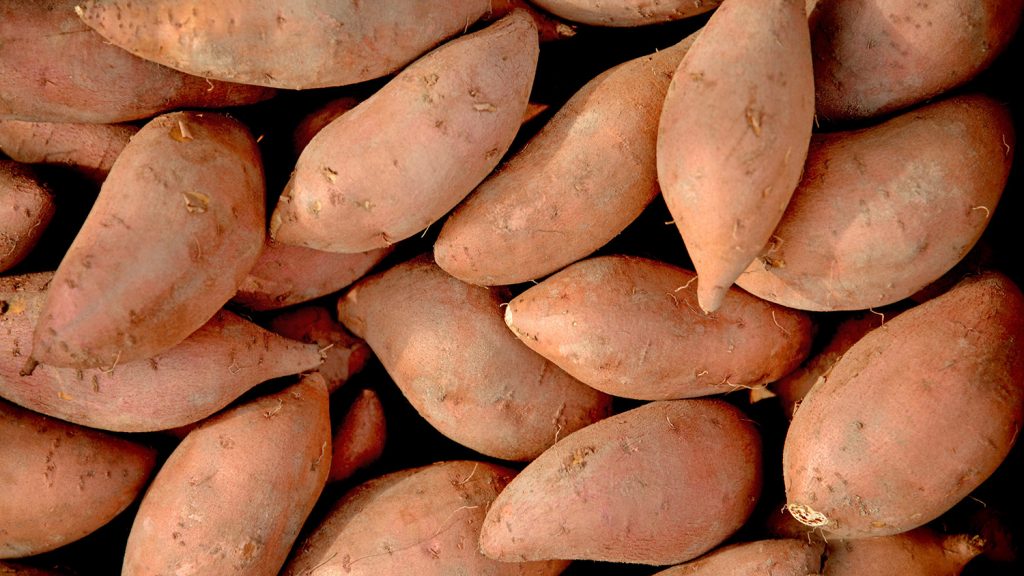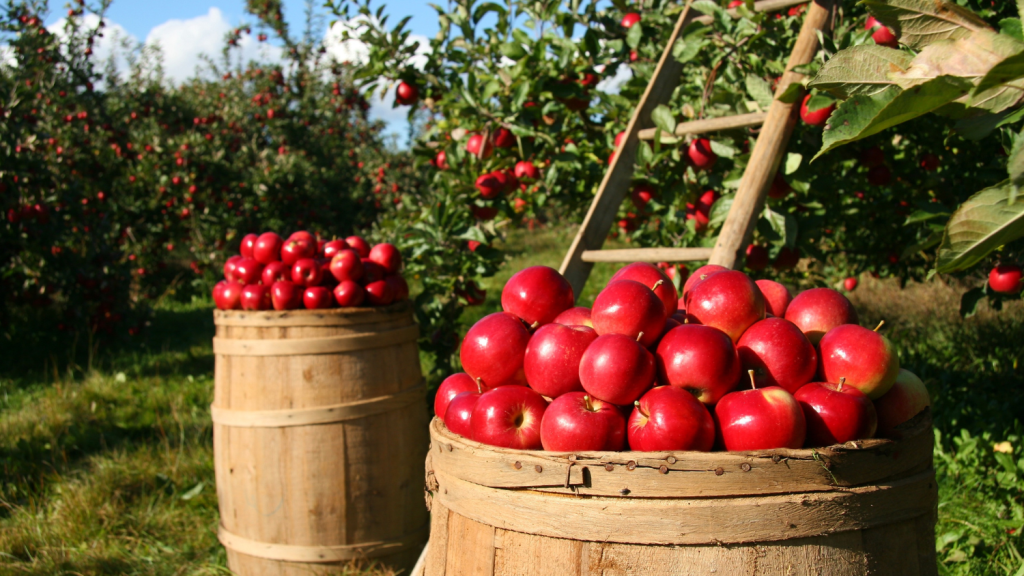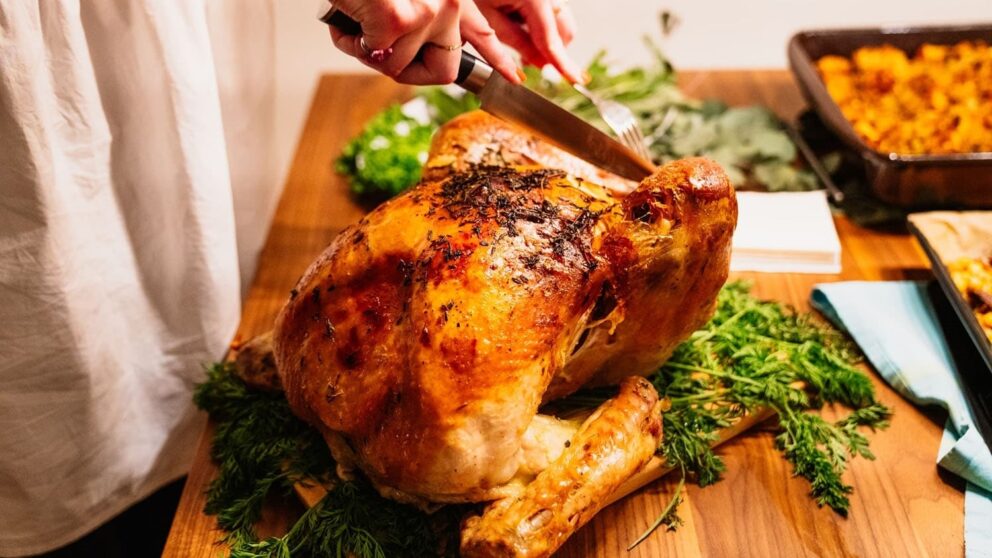Written by Chris R. Gonzalez
As you glance around your holiday table, you may find it comforting to know that many of the traditional Thanksgiving foods were likely grown or raised in North Carolina. Our state takes production bragging rights for at least three of the top holiday dishes. North Carolina ranks 1, 2 and 3 throughout the U.S. in sweetpotatoes, turkey and ham, respectively.
“I can just about guarantee that someone can make an entire holiday meal just on what is produced in North Carolina. Turkey, goose, duck, quail, chicken… sweetpotatoes, squash, sweet corn, beans, carrots, onions, broccoli, well I guess some people even eat cauliflower,” says Jesse Grimes, turkey management Extension specialist.
The USDA statistics report that North Carolina raised 30 million turkeys in 2021, 10 million less than the largest producer, Minnesota.
“I was raised here in North Carolina, and my favorite part of the [Thanksgiving] meal is the turkey,” Grimes says. “My mom would take every bit of meat off the bone and make turkey hash. Her white gravy with chopped hard-boiled eggs, a gravy base over biscuits, it’s every bit as good as sausage gravy.”
While a big steaming turkey may be the star of a holiday spread or at least depicted as such in a Norman Rockwell painting, the most consumed item might be the state’s no. 1 edible crop, the sweetpotato. Many families will serve up sweetpotatoes in a variety of ways: as a marshmallow-topped casserole, a simple pie, oven roasted with other vegetables or as seasoned fries for the grandkids, dipped in Ranch dressing, of course.
“Sweetpotatoes have to go with collards. You definitely expect to have sweetpotatoes or yams as we call them. Typically, my mom made two to three sweetpotato pies each Thanksgiving because my family is big sweetpotato eaters,” says Deanna O’Pharrow Anderson, ’82 NC State alumna.
Growers and promoters come up with enticing new ways to eat even more sweetpotatoes, such as slicing them thin to replace corn chips in a nacho twist, or as a main cornbread ingredient, and even as Pina Colada sweetpotato popsicles, according to recipes from the North Carolina SweetPotato Commission.

“I’m not allowed to show up at a family function without cheesy sweetpotato sausage spread. It is this warm gooey goodness, filled with all those naughty calories we deprive ourselves of all year. It is comfort in a bowl,” states NC SweetPotato Commission Communication Specialist CoCo Daughtry.
Daughtry says there are lots of fun sweetpotato recipes on the commission’s site. One of her favorites is Friday night lights Thanksgiving bites, mostly made from leftovers of the big meal. It once won first place in the Mountain State Fair Tailgate Recipe Contest.
“And if you really want to get a jump on the holidays, we have sweetpotato eggnog with coconut milk and spiced rum,” she says.
Daughtry states that the sandy North Carolina soil is the reason for premium sweetpotatoes. “Our soils produce the sweetest, most magnificent sweetpotato you could taste… we are the best of the best,” she says.
Thanks to a letter-writing campaign by Mrs. Celia Batchelor’s fourth-grade class and the citizens of Wilson, the sweetpotato was named the Official Vegetable of the State of North Carolina in 1995.
Over 100,000 of the 8 million farm acres in our state are planted with sweetpotatoes. North Carolina produces about 1.8 billion pounds of sweetpotatoes for 63% of the market in the U.S. with California a far behind second producer at 610.5 million in 2021.
Because it is a feast, a second main meat is often part of the Thanksgiving spread, and ham is a big staple in the south. Virginia might be known for theirs, but our state ranks third in production each year, behind Iowa and Minnesota.
Ham was a staple of colonial cuisine. British settlers brought razorback pigs with them and sold the meat to other parts of colonial America. The ham industry set down its deepest roots in the town of Smithfield, Virginia, reports NPR.

There are about 8 million hogs being raised in the southeastern North Carolina counties of Duplin, Sampson, Bladen and Robeson. And whether you like your ham smoked, brown sugar glazed, salt or sugar cured or drowning in maple bourbon rub, there’s no denying that some holiday guests prefer moist ham to turkey.
Rounding out those other Thanksgiving meal staples, for corn we rank 19th and for collard greens, the official vegetable of South Carolina, we often rank 3rd. We don’t make top rankings for potatoes, green bean casserole ingredients, wheat for stuffing or cranberry sauce. Just about any produce you may want can be bought in stores and local farmer’s markets.
“We grow all kinds of crops. If someone has a big enough garden, they can produce just about anything in North Carolina, I’m confident that someone can produce all aspects of a meal from things grown here,” Grimes says.
Other of the state’s top crops may not be on a serving platter, but they likely went into the bird you’re carving.
“The grains for turkeys can also be grown here. Corn, soybeans, wheat and the minerals fed to turkeys can be produced in North Carolina,” Grimes says.
He is quick to point out that the turkeys raised in North Carolina come from family farms and the birds are well taken care of. The age of the typical turkey you will feast on is anywhere from 12 to 20 weeks old.
“It is not part-time. They check on them multiple times during the day paying attention to the details. They do a fantastic job. The reason we put birds in buildings is to provide a proper environment. Once a turkey is hatched, it needs to be kept at a certain temperature. As it gets older, it needs more air and ventilation. Family farms provide all that,” Grimes states.
What’s the best way to cook a turkey? It’s all personal preference, but Grimes makes a plug for frying whole turkeys.
“You can use peanut oil, made in North Carolina, and it does two things.There is a higher flashpoint that holds the heat well and cooks faster, and peanut oil adds extra flavor to the turkey. Plus it’s faster, and it turns out crispy skin,” he says, and if you’re still not sure whether to bake or fry, “fix one each way.”
Don’t forget that the state grows a variety of fruits great for incorporating into desserts, including strawberry and blueberry crumble, peach cobbler, apple or pumpkin pie. And last but not least, there are nearly 200 wineries and over 300 breweries to add festive libations to any celebration.

This post was originally published in College of Agriculture and Life Sciences News.
